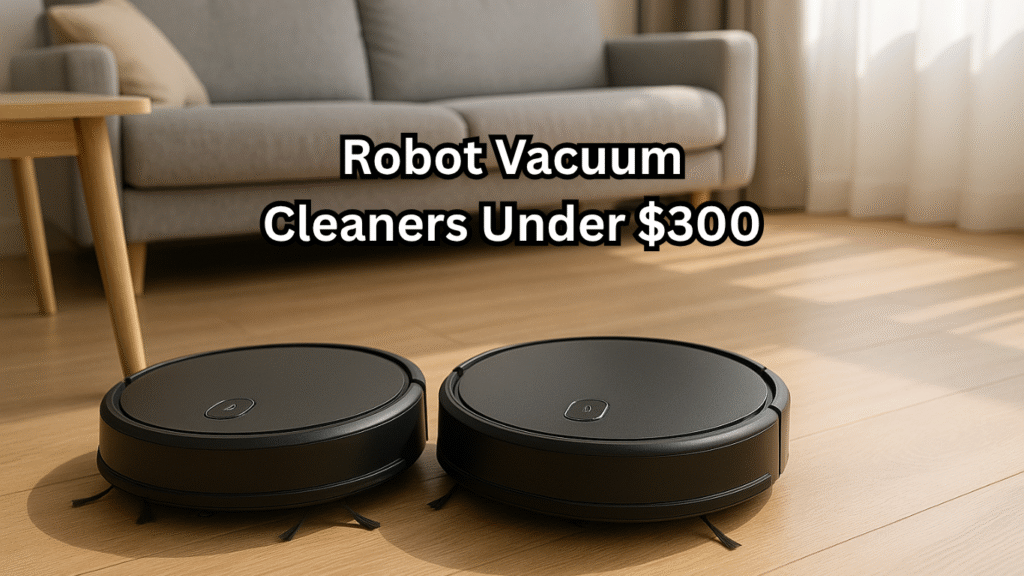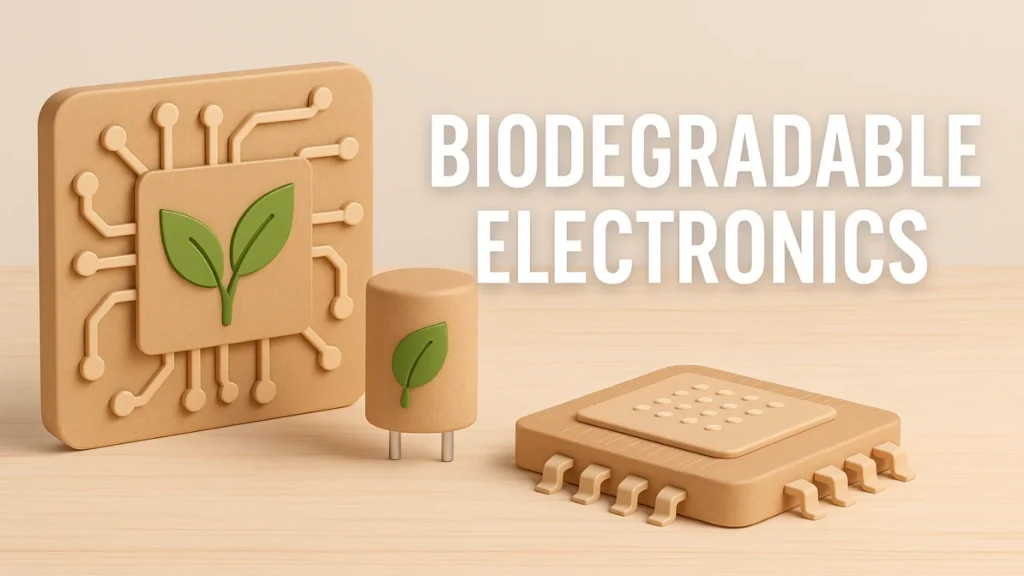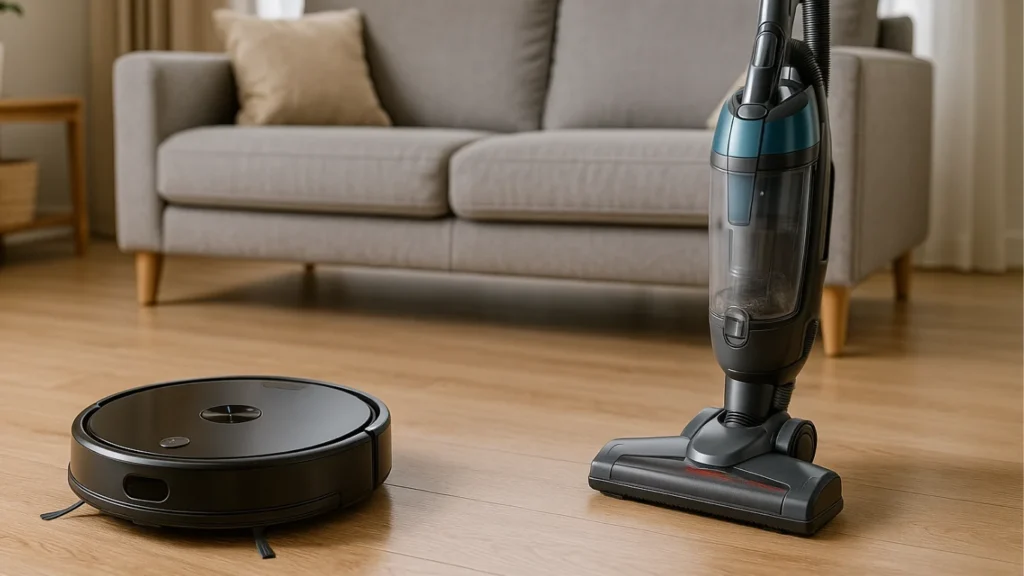
Vacuuming has always been a necessary but time-consuming chore. But in 2025, the debate of robot vacuum vs traditional vacuum has become more relevant than ever as households turn to smart home solutions to save time and effort.
With rapid advancements in artificial intelligence, mapping technology, and automation, robot vacuum cleaners are no longer just futuristic gadgets; they’re real contenders to replace conventional vacuum cleaners in many homes.
On the other hand, traditional vacuums have evolved too, offering more power, versatility, and reliability. So, when choosing between a robot vacuum vs traditional vacuum, which one truly suits your lifestyle, cleaning needs, and budget in 2025?
In this article, we’ll break down everything you need to know, from how each type works to performance comparisons, costs, pros and cons, and expert recommendations.
Whether you’re a busy professional, a pet owner, or a parent with toddlers, this guide will help you decide which vacuum cleaner is the better investment for your home in 2025.
How a Robot Vacuum Cleaner Works
A robot vacuum cleaner is an intelligent, autonomous device designed to clean floors without human intervention. It uses a combination of sensors, mapping technology, and motorized cleaning components to navigate your home and pick up dust, debris, and pet hair.
1. Sensors and Navigation
Robot vacuums rely on a mix of infrared sensors, optical sensors, gyroscopes, and LiDAR (Light Detection and Ranging) to detect walls, furniture, stairs, and even tiny obstacles. This helps the device create a digital map of your floor space and move efficiently without crashing into objects or falling down stairs.
2. Smart Mapping & AI Algorithms
Many models in 2025 come equipped with AI-based smart mapping systems like SLAM (Simultaneous Localization and Mapping).
These systems allow the robot vacuum to learn your home’s layout, remember room names, and plan cleaning routes based on usage history. Some even offer multi-floor mapping.
3. Brushes, Rollers & Suction Mechanism
Under the hood, a robot vacuum features rotating side brushes, a central roller brush, and a suction motor. The brushes sweep dirt from corners toward the center, while the roller picks up the debris and the motor sucks it into a built-in dustbin.
4. Obstacle Avoidance & Anti-Drop Sensors
Modern robot vacuums are equipped with object recognition to avoid socks, cords, pet bowls, and toys. Anti-drop sensors prevent them from falling off stairs or raised platforms.
5. Docking & Recharging
When the battery is low or the cleaning cycle is complete, the robot automatically returns to its charging dock. Some advanced models also have auto-empty stations that remove collected dust into a larger bin, making the process completely hands-free.
6. App & Voice Control
Most 2025 robot vacuums can be controlled via smartphone apps or integrated with smart assistants like Alexa or Google Home. Users can start, pause, schedule, or monitor cleaning progress in real-time from anywhere.
How a Traditional Vacuum Cleaner Works
A traditional vacuum cleaner is a manual, motor-powered cleaning device that relies on human operation to move across floors, carpets, or furniture.
Despite technological upgrades over the years, its fundamental design remains centered around powerful suction and manual control.
1. Suction and Filtration System
At the core of a traditional vacuum cleaner is a powerful electric motor that creates negative pressure (suction) to pull dirt, dust, and debris through a nozzle.
The air and the particles it carries are typically passed through one or more filters (e.g., HEPA filters) before being released back into the room.
2. Brush Rollers and Attachments
Most vacuums have a rotating brush roll that agitates carpet fibers and loosens dirt. For hard surfaces or delicate materials, users can switch to soft bristle attachments or suction-only modes.
Various extensions like crevice tools and upholstery brushes help clean corners, drapes, stairs, and furniture more thoroughly.
3. Power Source and Operation
Traditional vacuums are powered either by a plug-in electrical cord or a rechargeable battery (in cordless models). Users push or pull the vacuum to guide it over surfaces, controlling direction, speed, and attachment use manually.
4. Dustbin or Bag Collection
Dirt is either collected in a replaceable dust bag or a reusable dustbin. Bagged vacuums usually offer better dust containment, while bagless models are easier to empty and more eco-friendly.
5. Manual Storage and Maintenance
After use, the vacuum needs to be manually stored, cords wrapped, and filters or bags checked. Regular cleaning and replacement of filters or belts are necessary to maintain performance.
6. No Smart Features
Unlike robot vacuums, traditional models typically lack smart features, mapping, or automation. While some modern cordless units include battery indicators and suction adjustments, most rely on physical operation without any app or voice control.
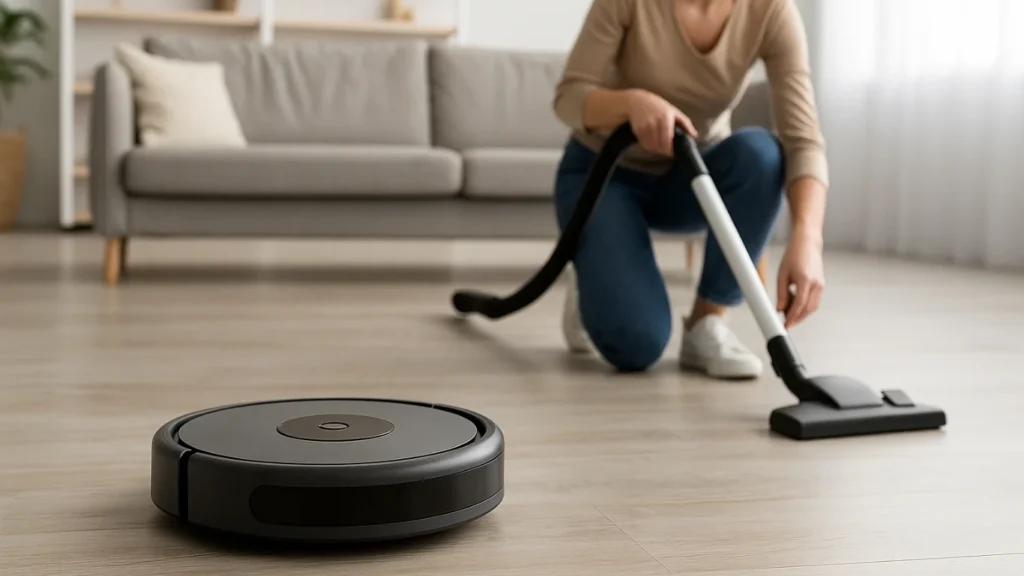
Robot Vacuum vs Traditional Vacuum: Feature Comparison Table (2025)
| Feature | Robot Vacuum Cleaner | Traditional Vacuum Cleaner |
|---|---|---|
| Cleaning Method | Automated; uses sensors, brushes, and suction | Manual; user-controlled suction and brush operation |
| Operation Mode | Autonomous (self-cleaning, scheduling via app) | Manual (requires physical effort to operate) |
| Navigation | Smart Mapping, AI Algorithms, Obstacle Avoidance | None; user navigates and controls movement |
| Cleaning Efficiency | Good for daily light cleaning and surface dust | Excellent for deep cleaning and heavy debris |
| Surface Compatibility | Works on hardwood, tile, low to medium carpets | Works on all surfaces including high-pile carpets |
| Pet Hair Removal | Effective, especially in newer models | Highly effective, particularly with specialized attachments |
| Maintenance | Self-emptying (in premium models); occasional bin cleaning | Requires regular filter, belt, and bag maintenance |
| Noise Level | Generally quiet (50–65 dB) | Louder (70–85 dB typical) |
| Storage Space | Compact, dockable, minimal space needed | Bulky; needs storage closet or corner |
| Cost Range (2025) | $200–$1,500+ (varies by smart features & brand) | $75–$500 (varies by type and brand) |
| Smart Home Integration | Yes – app, Alexa, Google Home support | Rarely, only in latest high-end cordless models |
| Battery Life | 60–180 minutes; auto-docks when low | Plug-in or 30–60 mins for cordless models |
| User Effort Required | Minimal (hands-free once scheduled) | High (manual setup, usage, and storage) |
| Best Use Case | Busy users, tech-savvy homes, daily upkeep | Deep cleaning, large messes, spring cleaning sessions |
In-Depth Comparison: Robot Vacuum vs Traditional Vacuum
1. Cleaning Performance
- Robot Vacuum Cleaner: Great for light to moderate cleaning. Its rotating brushes and suction mechanism can handle dust, pet hair, and small debris on hard floors and low-pile carpets. However, it may struggle with deep-set dirt, thick rugs, and cluttered rooms.
- Traditional Vacuum Cleaner: Superior for deep cleaning. With powerful motors, interchangeable attachments, and user control, traditional vacuums easily extract embedded dirt, hair, and allergens—even from high-pile carpets and upholstery.
Winner: Traditional Vacuum Cleaner (for deep cleaning)
2. Automation and Ease of Use
- Robot Vacuum Cleaner: Fully automated with scheduling, app control, and auto-recharging. Once set up, it can clean your home even when you’re not there. Some models also self-empty, making the experience completely hands-free.
- Traditional Vacuum Cleaner: Requires manual operation from start to finish—plugging in, pushing across floors, and storing after use. Even cordless models need physical handling.
Winner: Robot Vacuum Cleaner (for convenience and automation)
3. Maintenance and Longevity
- Robot Vacuum Cleaner: Needs regular dustbin emptying (unless self-emptying), occasional brush cleaning, and periodic software updates. Replacement parts like brushes and filters have to be bought every few months.
- Traditional Vacuum Cleaner: Also needs maintenance, bag or bin cleaning, belt changes, and filter replacements, but parts are often more durable and cheaper over time.
Winner: Tie – Robot vacuums are lower-effort, but traditional ones may be more durable long-term.
4. Cost and Value
- Robot Vacuum Cleaner: Can be expensive, especially premium models with LiDAR, AI, and auto-empty bases. Entry-level units start around $200, while top-tier models can go over $1000.
- Traditional Vacuum Cleaner: Generally more budget-friendly. Powerful upright or canister vacuums cost between $100 and $500, with cordless models slightly higher.
Winner: Traditional Vacuum Cleaner (for initial affordability)
5. Noise Levels
- Robot Vacuum Cleaner: Operates quietly (typically 50–65 decibels), making it ideal for night use or homes with babies and pets.
- Traditional Vacuum Cleaner: Much louder, especially in high-suction modes. Can reach 75–85 decibels or more, often requiring daytime use only.
Winner: Robot Vacuum Cleaner (for low noise)
6. Energy Efficiency
- Robot Vacuum Cleaner: Uses low energy over longer durations. Some models even offer eco-modes that adjust suction to save power.
- Traditional Vacuum Cleaner: Consumes more power quickly, especially plug-in models with strong suction motors.
Winner: Robot Vacuum Cleaner (for energy savings)
7. Storage and Portability
- Robot Vacuum Cleaner: Compact, lightweight, and stored in a charging dock. It blends into home décor and doesn’t require much space.
- Traditional Vacuum Cleaner: Bulky and sometimes heavy. Uprights, canisters, and hoses take up closet space and require manual lifting and setup.
Winner: Robot Vacuum Cleaner (for small-space convenience)
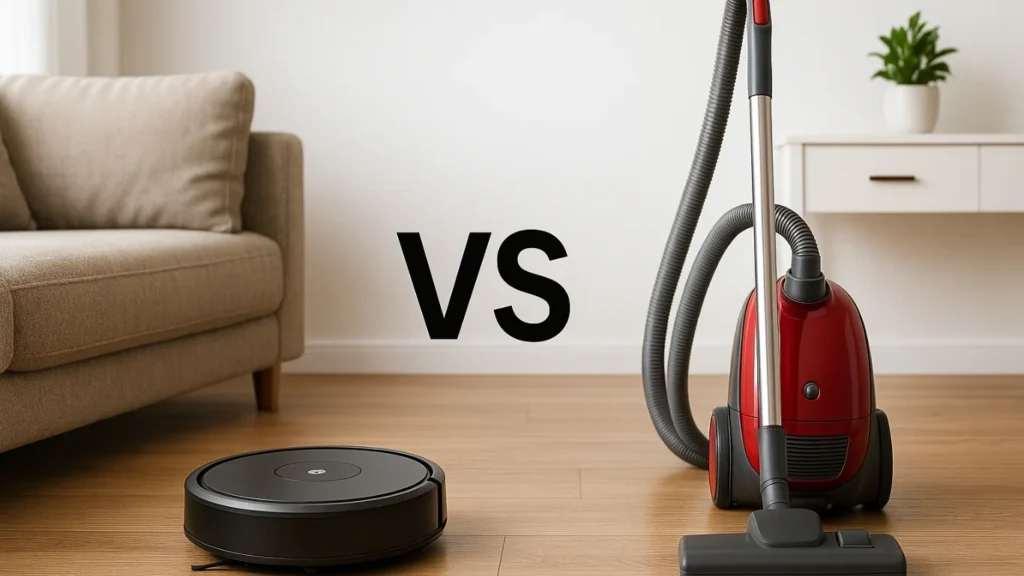
Use Case Scenarios: When to Choose a Robot Vacuum or a Traditional Vacuum
Choosing between a robot vacuum vs traditional vacuum depends on your home setup, lifestyle, and cleaning needs. Below are real-world scenarios to help you decide which vacuum is better suited for different types of users in 2025:
1. Busy Professionals
- Robot Vacuum: Ideal for individuals who work long hours or travel frequently. You can schedule cleanings via a mobile app so that floors stay clean without lifting a finger. The robot works while you’re at work, asleep, or away from home.
- Traditional Vacuum: May not be practical due to the time and effort involved. You’ll need to carve out time on weekends or evenings to vacuum manually.
Best Choice: Robot Vacuum Cleaner
2. Pet Owners
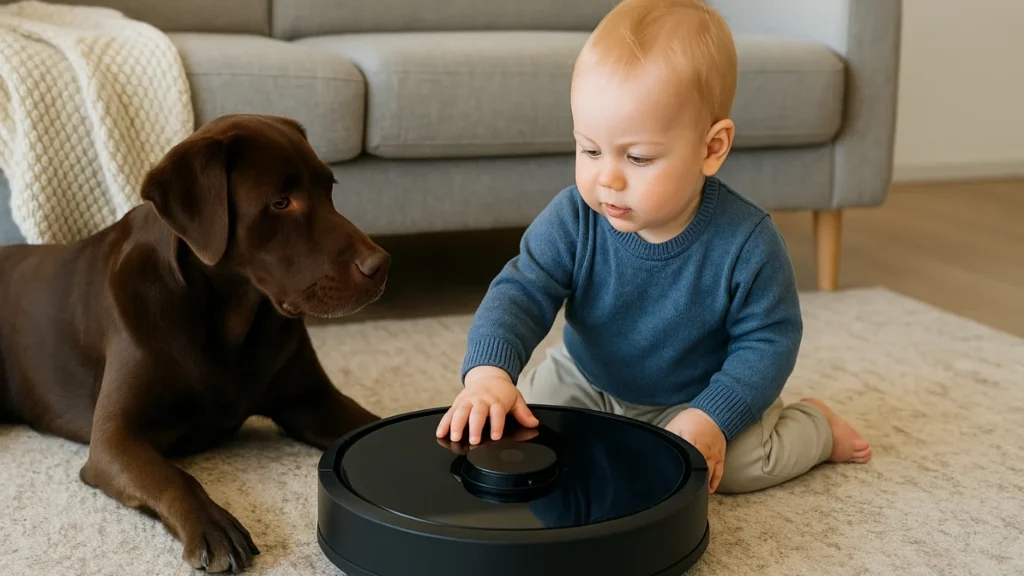
- Robot Vacuum: Great for daily cleanup of pet hair, litter, and dander. Models with HEPA filters and rubber brushes are especially pet-friendly. However, if your pet sheds heavily or tracks in dirt, a robot may need to run more often.
- Traditional Vacuum: Offers stronger suction and is more effective for deep cleaning areas with concentrated pet fur, like rugs, pet beds, and couches. Specialized attachments can remove hair from upholstery better than a robot can.
Best Choice: Use both – robot for daily hair pickup, traditional for weekly deep cleans.
3. Parents with Toddlers
- Robot Vacuum: Helps maintain a cleaner floor throughout the day, especially in high-traffic play areas. It’s useful for frequent cleaning of crumbs, dust, and small debris without disturbing nap times due to its low noise.
- Traditional Vacuum: Better for cleaning after art projects, spills, or heavier messes. However, its noise and bulkiness may disturb sleep or be less safe around curious toddlers.
Best Choice: Robot Vacuum Cleaner, supported by occasional traditional vacuuming.
4. Elderly or Physically Limited Individuals
- Robot Vacuum: A game-changer for seniors or those with back, knee, or joint problems. It reduces the need for bending, carrying heavy equipment, or manually pushing a vacuum across the floor.
- Traditional Vacuum: Could be challenging to use due to weight, handling, and setup—though lightweight stick vacuums can be an alternative.
Best Choice: Robot Vacuum Cleaner
5. People Living in Large Homes
- Robot Vacuum: Efficient for consistent daily upkeep in large homes, especially if the model supports multiple-floor mapping. However, cleaning may take more time due to battery limits.
- Traditional Vacuum: More effective for thorough cleaning of multiple rooms and high-pile carpet areas in a single session, especially if you want quick results.
Best Choice: Use Both – robot for daily routine, traditional for deep cleaning.
6. Small Apartment or Studio Residents
- Robot Vacuum: Perfect for compact spaces. It docks in a corner, runs quietly, and can navigate tight layouts with ease.
- Traditional Vacuum: May be overkill for small spaces, and storing a bulky unit in a studio could be inconvenient.
Best Choice: Robot Vacuum Cleaner
7. Tech Enthusiasts & Smart Home Users
- Robot Vacuum: Seamlessly fits into smart ecosystems. You can start cleaning with a voice command, set up routines, or monitor cleaning maps in real-time from your phone.
- Traditional Vacuum: Generally lacks integration with smart tech. Some modern cordless models may have a display screen or battery meter, but they’re not truly “smart.”
Best Choice: Robot Vacuum Cleaner
Pros and Cons: Robot Vacuum vs Traditional Vacuum
Understanding the strengths and limitations of each vacuum type can help you make a smarter buying decision. Here’s a side-by-side breakdown:
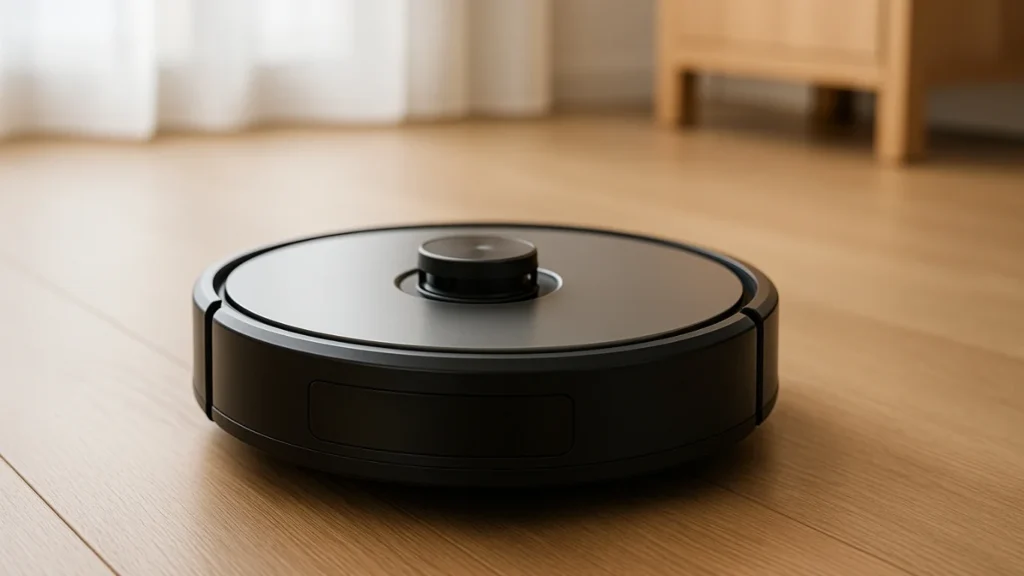
Robot Vacuum Cleaner
Pros:
- ✅ Hands-Free Cleaning: Cleans on its own with zero physical effort once set up.
- ✅ Smart Features: Controlled via app or voice; can schedule, map, and auto-recharge.
- ✅ Quiet Operation: Operates with minimal noise, great for night cleaning or households with kids.
- ✅ Space-Saving: Compact design fits under furniture and docks neatly when not in use.
- ✅ Consistent Upkeep: Great for daily maintenance to prevent dirt buildup.
Cons:
- ❌ Expensive: Premium models with mapping and self-emptying features can cost over $1,000.
- ❌ Surface Limitations: Less effective on thick rugs, stairs, and complex messes.
- ❌ Battery Dependent: May not finish large jobs on one charge; downtime while recharging.
- ❌ Maintenance of Sensors: Needs occasional cleaning of wheels, sensors, and brushes.
- ❌ Not Ideal for Deep Cleaning: Can miss corners or areas behind objects.
Traditional Vacuum Cleaner
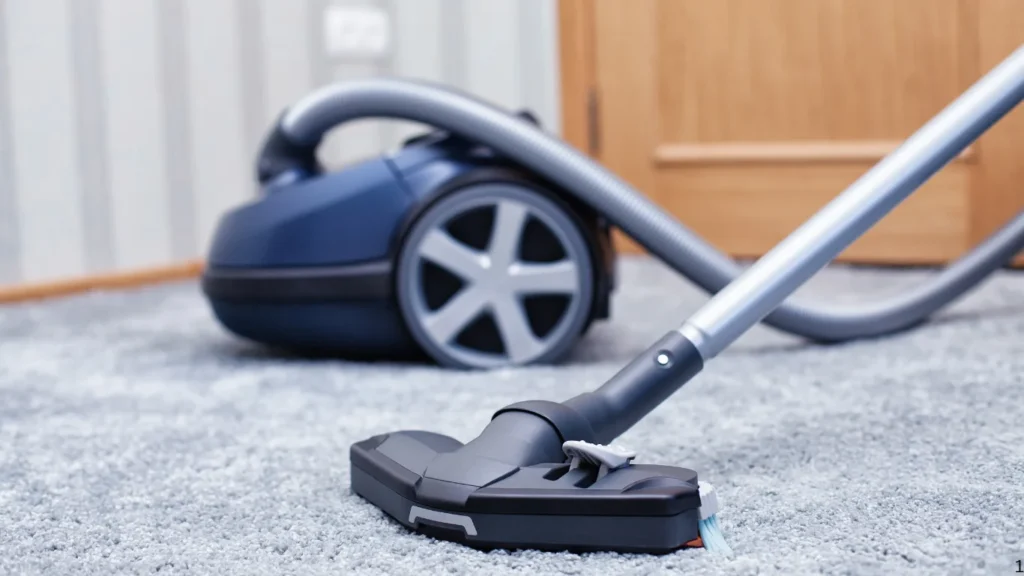
Pros:
- ✅ Powerful Suction: Ideal for deep cleaning thick carpets, rugs, and embedded debris.
- ✅ Versatile Tools: Attachments handle stairs, drapes, upholstery, and furniture easily.
- ✅ Reliable for All Messes: Handles large debris, liquids (in wet-dry models), and heavy-duty cleaning.
- ✅ Lower Upfront Cost: Generally cheaper than high-end robot vacuums.
- ✅ No Tech Setup Needed: Just plug and clean—no apps or updates required.
Cons:
- ❌ Manual Effort: Requires pushing, lifting, plugging in, and physical movement.
- ❌ Bulky and Noisy: Louder operation and storage can be a hassle in smaller homes.
- ❌ Not Automated: No scheduling or smart features unless you buy advanced cordless versions.
- ❌ Time Consuming: You must be present and actively involved in the cleaning process.
- ❌ Cords and Bags: Older models can be annoying with tangled cords and frequent bag changes.
Why Robot Vacuum Cleaners Are Important in 2025
The conversation around robot vacuum vs traditional vacuum has evolved significantly due to the changing needs of modern households.
In 2025, robot vacuum cleaners are not just helpful gadgets; they’re becoming essential tools for cleaner, smarter, and more efficient living.
1. Busy Lifestyles Demand Automation
Time is one of the most valuable commodities in 2025. With more people working remotely, managing side hustles, or juggling family responsibilities, daily chores like vacuuming become a burden.
A robot vacuum cleaner works on autopilot, freeing up time for what truly matters: work, rest, or quality time with family.
2. Health and Hygiene Prioritized
Post-pandemic awareness has made hygiene a top priority in homes. Robot vacuums with HEPA filters and daily cleaning cycles help reduce allergens, bacteria, and dust buildup. This is particularly important for families with infants, elderly members, or people with allergies.
3. Smart Home Ecosystems Are the New Normal
As more homes integrate smart devices like thermostats, lights, and security cameras, robot vacuums fit naturally into this ecosystem.
You can program them with voice assistants like Alexa, link them to routines (e.g., start cleaning when you leave the house), or control them remotely through mobile apps.
4. AI and Mapping Technology Are Now Affordable
In 2025, AI-powered robot vacuums that once cost over $1000 are now available in the $300–$500 range. These units feature LiDAR navigation, object recognition, and intelligent cleaning paths, making them a practical solution even for average households.
5. Elderly and Physically Limited Users Need Help
Robot vacuums bring independence to seniors and people with disabilities. Instead of relying on help for daily cleaning or struggling with heavy vacuums, they simply press a button or use voice command, and let the robot do the job.
6. Environmental Efficiency
Today’s robot vacuums are designed to be energy-efficient. They use just enough power to do the job and avoid unnecessary cleaning repetitions, reducing overall electricity consumption compared to some traditional plug-in models.
In summary, the importance of robot vacuum cleaners in 2025 lies in their ability to merge efficiency, convenience, and smart technology, making them an integral part of the modern home.
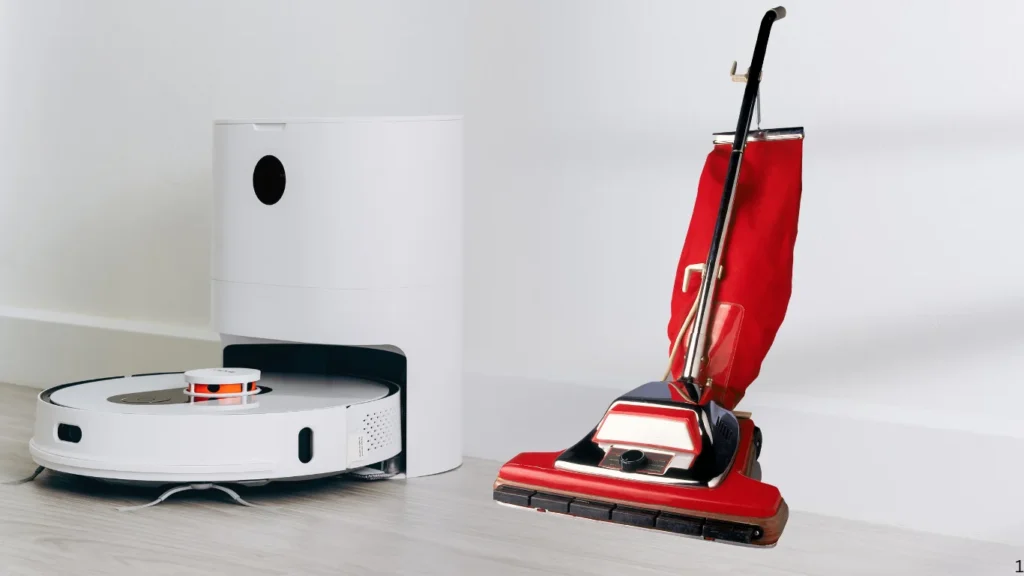
Which One Should You Buy in 2025?
Choosing between a robot vacuum vs traditional vacuum in 2025 depends on your lifestyle, home layout, budget, and cleaning preferences. Both have strengths, but one may be a better fit for your specific needs.
✅ Choose a Robot Vacuum Cleaner If:
- You have a busy schedule and want to automate routine cleaning.
- Your home has mostly hard floors or low-pile carpets.
- You value smart home features like app control, scheduling, and voice commands.
- You live in a small to medium-sized apartment or want a hands-free solution.
- You’re a tech enthusiast or someone who prioritizes energy-efficient and quiet cleaning.
✅ Choose a Traditional Vacuum Cleaner If:
- You have lots of thick rugs, high-pile carpets, or stairs to clean.
- You need powerful suction for deep cleaning, pet hair, or tough messes.
- You prefer a lower-cost option or don’t need automation.
- You live in a large household with heavy foot traffic and more dirt.
- You’re comfortable with manual effort in exchange for a thorough clean.
Many modern homes are investing in both types of vacuums. A robot vacuum handles daily light cleaning, maintaining cleanliness without effort, while a traditional vacuum is used weekly for deep-cleaning floors, rugs, and upholstery.
This hybrid approach ensures maximum efficiency and cleanliness with minimal effort.
FAQs About Robot Vacuum vs Traditional Vacuum
Q1: Is a robot vacuum cleaner as powerful as a traditional vacuum?
No. While robot vacuums are great for daily surface cleaning, traditional vacuums typically offer stronger suction and are better for deep cleaning thick carpets or heavy messes
Q2: Can a robot vacuum completely replace a traditional vacuum in 2025?
For many users, especially in small or tech-savvy homes, yes. But for households with pets, kids, or large floor spaces, a robot vacuum is best used alongside a traditional vacuum.
Q3: How often should I use a robot vacuum vs traditional vacuum?
Use a robot vacuum daily for maintenance and dust control. Use a traditional vacuum weekly or bi-weekly for deep cleaning, especially in high-traffic areas or homes with pets.
Q4: Are robot vacuums safe for pets and kids?
Yes. Most modern robot vacuums are pet- and child-friendly. They use obstacle detection to avoid toys and bowls, and many operate quietly enough not to disturb naps or playtime
Q5: Which is more eco-friendly: robot vacuum or traditional vacuum?
Robot vacuums are typically more energy-efficient since they consume low power and avoid over-cleaning. However, traditional vacuums can also be eco-friendly if used properly with reusable filters and eco modes.
Q6: Do robot vacuums work on stairs?
No. Robot vacuums cannot clean stairs. You’ll still need a traditional vacuum or handheld vacuum for staircases and elevated surfaces.
Q7: What is the lifespan of a robot vacuum vs a traditional vacuum?
With regular maintenance, both can last 5–8 years. However, robot vacuums may require more frequent software updates and part replacements (like brushes and sensors), while traditional vacuums may need belt or bag replacements.
Q8: Which one is cheaper in the long run?
Traditional vacuums have a lower upfront cost, but robot vacuums save time and may reduce cleaning frequency. Over 5+ years, the overall cost depends on how often you clean and whether you value time or budget more.
Q9: Can I use a robot vacuum if I have multiple floors?
Yes. Many 2025 models support multi-floor mapping. You’ll need to carry the unit to the other floor, but it will remember each layout and clean accordingly.
Q10: What’s the best vacuum type for allergy sufferers?
Both types can help if they include HEPA filtration. However, robot vacuums can maintain cleaner air daily, while traditional vacuums may remove more allergens during deep cleaning.
Conclusion:
In the ongoing debate of robot vacuum vs traditional vacuum, there’s no one-size-fits-all answer—only the best choice for your unique lifestyle and home needs. In 2025, robot vacuum cleaners are smarter, quieter, and more efficient than ever.
They excel in daily cleaning, automation, and integration with smart homes. On the other hand, traditional vacuums remain unbeatable for deep cleaning and handling heavy dirt in large or carpeted spaces.
If you value convenience, technology, and a hands-off approach to cleanliness, a robot vacuum could transform your routine. If power, control, and thorough cleaning matter more, a traditional vacuum may still be your best friend.
Ultimately, many modern households benefit from owning both—combining daily automation with weekly deep-cleaning power. Whichever route you choose, the key is to invest in a vacuum that fits your lifestyle, budget, and home environment.
Read more: What is a Robot Vacuum Cleaner & How Does It Work?
Read more: Best Consumer Gadgets for Everyday Use in 2025
Anurag Ghosh is the founder of Tech Fashion USA, a website dedicated to bringing readers the latest trends in electronics, gadgets, AI innovations, and smart tech. With a passion for simplifying complex technology, Anurag curates well-researched, easy-to-understand articles that help consumers make smarter buying decisions. Whether you’re exploring the future of wearable tech or comparing the best AI-powered gadgets, Anurag’s insights are always grounded, practical, and focused on what truly matters to everyday users. Follow his work for unbiased reviews, breaking tech news, and expert buying guides.

